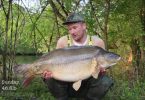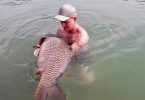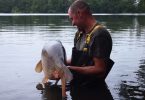I was recently watching an outdoor television show that got me thinking. The host was presenting his views on the five outdoor sounds he rates amongst his finest. Being an American program, it focused on their indigenous animals. It went something like this, in descending order – the clashing antlers of dear during the rut, wild turkeys calling in the spring, the high pitched whistle from a mature elk bull, a screaming fly reel on the flats, and lastly the rising sun! Other than the LSD laced creators of Tellie Tubbies, I doubt any of us have ever physically heard to the sun rise. The point the presenter was putting across however was beautifully simple. After eliminating every day sensory distractions that bombard and smother most of us during every day working life; in the bush, or on the water, we can focus our senses, wholeheartedly, on the natural environment surrounding us. Thereby, if not literally, then figuratively listen to the sun rise before us.
In risking comparing the relatively infant art of fly fishing with the age-old, life-giving rising of the sun, I do believe a wonderful analogy can be drawn between listening to the rising sun and simplifying our fishing. And in doing this, truly connecting with our piscatorial adversaries, and the environment they inhabit.
This point was pleasantly brought home to me on a recent guiding excursion on the upper Zambezi. After meeting with my clients, a good half an hour was spent transferring an array of tackle, electronic equipment, including GPS, fish finders, thermometers and two way radios on to our boat which was to transfer us, and our belongings, to Sekoma Island, our fishing camp for the week. Having fished these waters extensively over the past six years, privately and with clients, I was looking forward to some world class tiger action.

Upper Zambezi Tiger
It was late September, water levels on the upper Zambezi are low at this time, clarity is excellent and water temperatures are heating up. All conducive to good fly fishing. The first day of the safari dawned, and it was decided to fish the deep channels, reed banks and drop offs on the main Zambezi. These areas are most productive over June and July when the waters recede off the flood plains into the main channel. Setting off with the sun rise, tackle all primed and ready, one cannot help envisaging solid strikes, gel spun induced line burns and monster fish. We, after all, are contemporary fly fisherman, the scales of success and failure being “gadgeticallyâ€, electronically, and technologically weighted in our favour. Watching the magenta African sun creep lazily over the horizon, casting river side fishing villages into smoke infused silhouettes is a magical experience.

Sunset and tiger fishing – Zambezi
On arrival at fishy looking waters, fish finders beeping as though in competition with the swamp boubou’s, fishing began in earnest. A couple of drifts, many casts, more beeps, and some solid fish later it was time to move off. Outboards were started and the light aluminium boat hopped easily onto the plane. Simultaneously, not three metres from the boat, a graceful goliath heron took to flight from the shelter of the reeds. The whistling of air through its primary feathers inaudible over the churning prop. And so the day carried on, more fish were landed, more leaders tied, more flies destroyed and more GPS co-ordinates entered. I will admit to playing devils advocate for the sake of this article, as 99% of the time this would constitute a perfect days fishing on the Zambezi. My clients and my experiences over the next couple of days are however, some of the fondest of my career.
Surrounding Sekoma and Ilombe islands are a myriad of channels, interspersed with rapids (including the productive Mambova Rapids), glides, deep runs, deeper holes, and an assortment of bank side structure. These waters are undeniably the most productive tiger fishing waters during the low water months of September and November. They do however present a major difficulty. Conventional boats, even the shallowest running aluminium boats, cannot gain access to these waters for risk of destroying outboard motors in the shallow rock laden channels. Jet boats, as used by a couple of the operators in the area, can gain access to stretches of this water, but accessible water diminishes as the water levels drop.
It was decided, with a lack of pressure after landing a couple of good fish, and a relaxed and adventurous client, that we would spend the second morning fishing and exploring the rapids and waters surrounding Sekoma and Ilombe Islands. An Indian canoe our craft of choice. And what an experience it was!
It was with a David-Livingstone-like aura around us that we slipped silently into the beckoning water of the Zambezi. The small whirlpools left by our paddles blending the reflected colours of sunrise. Tactics were to focus on the rapids and runs, with their accompanying deep holes, eddies and differing current speeds. Paddling down and across the rapids we were able to enter the quite, swirling waters, behind the bigger protruding rocks marking the heads of the respective rapids. If the rocks were big enough, and offered adequate protection from ever present, if not visible, crocs we were able to disembark from the canoe and fish off the rocks. If this was not possible, the eddying water pushing up stream was adequate to keep the Indian canoe in a suitable position from where one could cast. It was on the second cast of the first rapid of the day that Duncan, from the UK, was stunned into the reality of tiger fishing as a hefty fish smashed his fly and preceded to run-off 20 yards of backing in a couple of adrenalin charged seconds. Trying desperately to obey instructions to keep his rod tip down, while concurrently gain some semblance of control over the enraged fish, Duncan watched in awe as a magnificent 11 pound fish burst out of the water at the tail end of the rapid. A memorable fight ensued before the fish was landed, weighed and released. A couple of casts later a smaller fish, in the region of eight pounds, was landed.

11 lb Tiger • upper Zambezi
Over the course of following four days we were submersed in any anglers and naturalist’s nirvana. Setting off in our Indian canoe at first light, drifting past feeding elephants, observing spotted neck and cape clawless otters feeding in the tranquil back waters, laughing as surprised African darters clumsily dropped off water berry trees into the river below, and listening to the eclectic sounds of the African bush was a surreal experience. The accompanying fly fishing was of the finest quality I have experienced in recent times. Most sessions resulted in more than one quality fish being landed and released, with a fair share of rats and mice (5lbs and below) to complement. A particularly memorable session, fishing off the canoe in some fast, shallow water (no more than two feet in depth) mid way down the Mambova rapids, resulted in seven strikes in as many casts. On a separate occasion, I was in the process of landing a modest size catfish that had fallen prey to heavily weighted black clouser, when a pair of tiger fish in the 10 lb range appeared out of the depths and began rushing the distressed catfish at my feet. I frantically called my client, three meters to my right, to cast at these aggressive fish. The bigger of the two fish nailed his fly as it hit the water and proceeded to spit him on the first jump. The second swiftly pounced on the injured fly and a wonderful aerial display followed. The most memorable fish of the trip, 15lb’s plus, was hooked in section of deep and quiet water, in between two sets of rapids. Drifting this stretch in the morning and noticing some aggressive surface activity, Duncan made a short cast behind a submerged rock. His fly was met with gusto on the sink. This magnificent fish took off like a steam train and was soon trailing 40 yards of backing. After 15 wrist burning minutes, Duncan had the fish within two metres of the canoe. I could taste the elation. It was with a sickening sensation that we watched, in slow motion, the hook pull and the magnificent brute slinked off into the Zambezi abyss.

Releasing a wonderful tiger
On a purely academic note; flies that consistently produced results were black clousers with a sparse amount of red buck tail tied under the wing and a fair amount of peacock hearl tied on top. Large, black, strip leach patterns with gold cactus chennille bodies, and all black zonker bait fish imitations tied palmered style, also shaped well. The majority of fishing was done using DI 3 sinking lines. DI 7 lines were needed to get down in some of the really deep fast flowing waters. If not casting directly to structure or likely looking lies, eddies and holes (all similar to what you would look for in a trout stream), blind casting was across and down. Casting across fast flowing turbulent water, mending the line as it bellied out, and then stripping into and out of the fast flowing water enticed positive strikes. And lastly casting directly down the cusp between the swift turbulent water of the rapids and the slow deep water eddying up stream, and allowing one’s fly to get right down, followed by a steady yet relatively slow strip retrieve up-stream produced excellent results. The limited space on an Indian canoe forces one to seriously consider tackle choice. There is no room to cart excessive tackle and equipment. Other than the compulsory cooler box and camera, a small day pack containing leader material, wire tippet, boga grip, pliers, a selection of flies, spare spools, binos, first aid kit, and a bird book was all that was needed.

Setting off on the Zambezi with the rising sun
Although I believe a competent fisherman should be familiar with all angling disciplines, each discipline complementing the other in some form. The art of fly fishing remains for me the most raw, uncluttered, and unadulterated. The lack of heavy rods and multiplying reels, ensure the contact between angler and fish is at its most primitive. This being said, it is human nature to hoard and collect. Fly fisherman often displaying above average symptoms of this nomadic trait. The resultant fact of the matter being, that before we know it, three anglers on a river could quite easily stock a small retail outlet by combining their fishing paraphernalia!
There is no doubt that today the scientific aspect of fly fishing is fast merging with the “artisticâ€. The multitude of gadgets, new and innovative fly tying materials, guide books, research material, state of the art tackle, and electronic equipment available to the modern fly fisherman has resulted in more sport fishermen catching a continuously depleting stock of fish. This “evolution†of the contemporary fly fisherman is definitely a natural progression, and in most cases, extremely welcome. However, in embracing the technological advances made available to us, I fear, at times we are distracted from the task at hand. Fundamentally this task being to catch fish, but on a more altruistic level….connecting with nature, escaping the monotony of working life, rekindling friendships and hopefully listening to the sun rise.
Keith Clover • Tourette Fishing
www.tourettefishing.com







